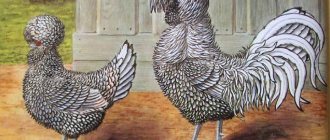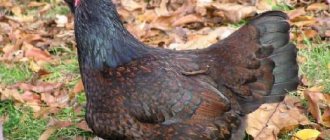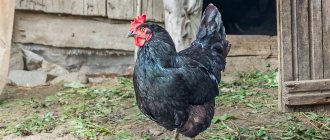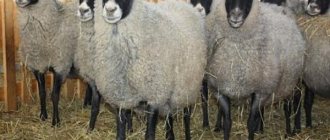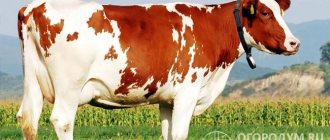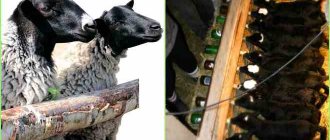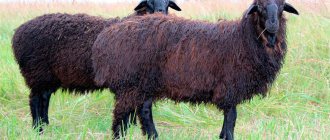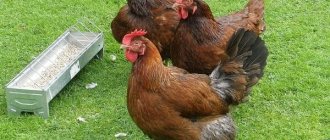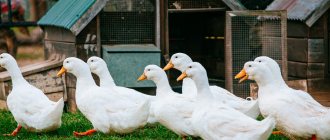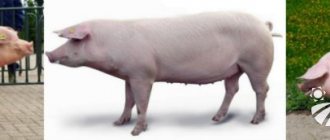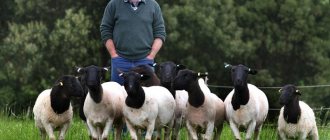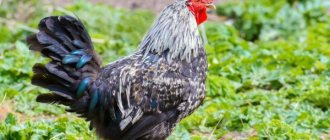The modern Liven breed of chickens is the result of the work of breeders to restore the once famous laying hen created by ordinary peasants. The bird became famous for its productive qualities not only in Russia, but also in Europe. In the 19th century, the British were the main consumers of large and tasty eggs obtained from this layer. Today this breed is not widespread; most often its feathered representatives can be found in the Oryol region or in the Poltava region, in Ukraine.
Liven laying hen
Origin story
This breed of chicken owes its name to the Livensky district of the Oryol province. It was here that the first specimens of poultry appeared, which were distinguished by their good weight and excellent eggs.
Savvy peasants, although they were not familiar with scientific methods of selection, were able to experimentally obtain an amazing breed group of chickens - Livensky.
Until the middle of the 20th century, Liven chickens could be seen in almost every homestead, and in the post-war years - in most poultry farms.
But, despite all the advantages, in the 60s of the last century the breed group was lost.
Nowadays, under the name “Livenskaya calico” you can find chickens of Ukrainian (Poltava) folk selection, which some poultry farmers consider to be revived Livenskaya, and some consider them to be a separate group “Ukrainian calico”.
It is worth noting that the calico color was not observed in the real breed group of Liven chickens.
Flaws
- Livenskaya breed of chickens is rare in our time.
- Aggressiveness of roosters.
So the article about the newly restored quotation has come to an end. Good luck and success to you! Share the material on social networks - let your friends also know about the revival of this species!
Subscribe to site updates and you will always be the first to receive new, interesting information about feathered beauties!
In the comments you can add your photos of laying hens, roosters and chicks! Did you like the article? Share with friends on social networks:
Description of the breed
Photo:
For several centuries, despite the large population of this breed in Russia, there was no official breed standard.
And only when work began to restore the breed in the middle of the last century. At the same time, a breed standard for Liven Calico chickens was gradually developed.
As a result, in 1990, the breed standard was officially adopted, according to which the appearance of the bird is as follows:
- the body is powerful, the chest is well developed, the back is wide and massive;
- head – medium size;
- a small leaf-shaped comb, pressed tightly to the head;
- small neck, thick, covered with feathers forming a mane;
- powerful straight beak - medium in size, yellow in color, but a darker color is also allowed;
- earrings – medium size, red;
- limbs are of medium size, colored the same as the beak;
- tail unit set vertically in relation to the body. The tail is medium in size; roosters have well-developed braids.
The color of the plumage is variegated, it combines white, red and black colors. In males, black feathers often have a green tint.
Chickens may have feathers on their limbs and a small crest that should not cover the comb.
Character
Representatives of the Livensky Calico breed are friendly and calm, even the cockerels rarely show aggression towards other inhabitants of the chicken coop.
However, they can sometimes attack the owner if they don’t like something in his behavior. Males practically do not sing.
Liven chickens are not shy, and even a sudden change of environment is not stressful for them. Representatives of the Livensky calico breed quickly get used to their owners.
External features
Representatives of this breed are distinguished by:
- white coloring combined with gray spots on the back and sides (black and motley pigs can occasionally be found);
- massive physique;
- weight up to 310 kilograms;
- impressive size (up to 176 centimeters in length);
- slight sagging of the belly;
- snub-nosed profile with large, fleshy, drooping ears;
- the presence of “earrings” in the lower part of the neck;
- correct shape, including a broad chest, short and strong legs, and a straight back.
Compared to the rest of the body, pigs' heads and necks are short.
Reviews
According to poultry farmers, the advantages of the breed include:
- unpretentious to living conditions;
- do not go overboard with food and gain weight well;
- produce high-quality eggs in significant quantities and meat with excellent taste;
- chickens lay eggs even in winter;
- In addition, they are good hens and caring mothers.
And the disadvantages are the following:
- aggressiveness of Liven roosters towards other chicken breeds;
- small distribution, which makes it very difficult to find chicks for breeding.
When they start rushing
As mentioned above, under good housing conditions, the breed in question begins to lay eggs already at 7 months.
Important: Calico hens lay large eggs. However, during the incubation period, the weight of the eggs decreases significantly. In addition, in late autumn the number of eggs laid also decreases.
When young chickens just start laying eggs, the size and clutch of eggs will be small. As a rule, in the first year the number of eggs laid by a young female is 80 units. However, next year, a healthy chicken will lay up to 200 pieces. In the third year the quantity will increase to 250-270 units.
As for the egg, its weight reaches 90 grams. The shell is light brown in color, and there are often two yolks inside. Giant eggs are in demand. For this reason, breeders prefer this breed.
Breeding
Liven chickens in most cases are able to hatch chicks.
The only problem is their weight - heavy quons often damage the eggs. For this reason, many farmers do not trust them with the responsible mission of breeding offspring, but use an incubator or a hen of a different breed.
For breeding, a rooster is selected whose exterior meets the standard.
Preference is given to males with average weight. Too large heads of families during mating games injure the hens, which then leads to pecking.
Raising young animals
Liven calico chickens take a long time to fledge, so greenhouse conditions need to be created for them.
Immediately after birth, the brood is placed in a brooder and in the first week of life is kept at a temperature of +30 ºС. The bedding inside is changed daily. After washing, the drinking bowl and feeder are scalded with boiling water.
Calico chickens are fed in the same way as representatives of other breed lines.
Their first food is a boiled egg. Then steamed small cereals, green onions, cottage cheese and vegetables are carefully introduced into the diet. Young animals are switched to whole grain feed at one month of age.
Care for adults
In order for the calico breed of chickens to grow well and delight with giant eggs, it will need to provide the following conditions:
- the pen for this species should not be cramped;
- Liven chickens love free grazing. Therefore, before breeding this breed, fence off the area for walking in advance;
- Don’t be afraid to let your birds roam in winter. They are adapted to low temperatures and love to peck snowballs;
- Before the onset of cold weather, most poultry farmers insulate their chicken coops. This procedure is not necessary if the calico breed is being raised;
- the litter in the brooder should be dry and laid in a thick layer;
- Don't place the hens' nest too high. Remember, this breed is large and heavy;
- Make sure there are enough seats for laying hens. Otherwise, you may find cracked eggs the next morning;
- provide the birds with calcium, add broken shell rock, chalk and fishmeal to the diet daily;
- Try adding chopped herbs to your chicken mashes. Green onions will make the eggs large. And for the winter, prepare dried nettles ahead of time.
If you prefer to feed your birds wet mash, do not leave them in the feeders for more than three hours in the summer. Otherwise, the food will spoil and the chickens that peck it will get sick.
Well, that's probably all. It remains to be added that experienced poultry farmers recommend sending the heaviest rooster into soup. The fact is that this breed is noted for cannibalism. Therefore, if there is no desire for the entire livestock to suffer, roosters for females should be left of medium size.
Summarizing all of the above, we emphasize that Livensky chickens are a successful combination of meat and egg qualities. Therefore, if you are just planning to start breeding birds in your backyard, you should take a closer look at this variety.
Content
Liven calico chickens are not suitable for cage keeping, only floor keeping. The birds will need a cozy, spacious home, a walking yard and good nutrition, then they will please the owner with good productivity.
Setting up a chicken coop
Calico chickens are well adapted to the climatic conditions of Russia.
They can be kept in an unheated poultry house, but the cracks must be well sealed and the walls, floor and roof insulated. The room temperature in winter should not fall below +8 ºС.
Birds are quite large, so they need a lot of free space. Two adults are placed per 1 m2. It is difficult for heavy laying hens to climb onto a high perch.
For ease of ascent and descent, it is equipped with gentle stairs. Each bird is allocated 35 cm of perch length.
Sawdust serves as bedding for chickens. Experienced farmers recommend mixing them with peat, then the material absorbs moisture better and retains heat.
As the wood chips become contaminated with droppings, turn them over to their full depth so that the surface remains dry and clean.
A mandatory requirement for arranging a chicken coop is normal air exchange.
The poultry house must be equipped with supply and exhaust ventilation or at least a window with an opening window. Constantly staying in a barn with stale air has a negative impact on the health and productivity of birds.
The drinking bowl and feeder are placed on the floor so that all residents of the chicken coop can approach them.
The length of the feed tape for large breed chickens is 20–25 cm. For every 7–8 birds, 1 nipple is left. Bowls with gravel and crushed shells are placed next to the feeder.
A trough or large basin filled with a sand-ash mixture is placed near the entrance. Sometimes chickens bathe in dust, thereby clearing the feather cover of ectoparasites.
The premises are cleaned regularly. Once a month, farmers add a layer of fresh sawdust, and twice a year they replace the old litter with new ones.
Walk
Those who want to have calico laying hens will have to arrange a run for them.
It is not necessary to build an aviary; it is enough to fence the area with a fence 1.2–1.5 m high, since birds cannot fly. The walking area is at least partially equipped with a canopy so that on hot days the birds can hide in the shade.
Attention! Free range is not suitable for this breed - curious laying hens will trample the beds and peck the berries.
Liven chickens need walking even in winter, however, the duration of walks in the cold season is reduced to 1 hour.
In summer, birds spend outside all day until dusk.
Daily walking helps strengthen the immune system, improve metabolism and increase productivity.
Feeding
An important aspect of caring for poultry is providing it with adequate nutrition. Of course, the age of the pets must be taken into account.
Chickens
If you have chicks, prepare to feed them about 12 hours after hatching.
Experts recommend making finely ground corn grits as your first meal; then you can give boiled yolk mixed with dry semolina.
Greens, such as nettles, will also help, but they must be boiled first. There are also special feeds for chickens of this age (starter feed).
After a few days, the grown chicks need a more varied diet, which may include:
- cereals (wheat, barley);
- potatoes and carrots, pre-cooked and grated;
- finely chopped green onions;
- fermented milk products - kefir or cottage cheese;
- feed for chickens according to age.
Further, the diet does not change much, only new types of cereals, soaked bread, and boiled fish are introduced. The number of feedings gradually decreases from seven to eight to five times a day.
When the chickens are a month old, they should eat grain - first coarsely ground, and after two weeks, whole grain. At this age, they are already walking outside with all their might, so fresh greenery is needed.
Important! Provide chicks with a daily dose of fresh water in drinking bottles and a separate feeder containing fine gravel, sand and crushed eggshells.
From three months old chickens are transferred to an adult diet, but food is given 4 more times a day.
Adult generation
Adult livens are not at all picky about food, but in order for the bird to remain healthy and productive, the diet must be balanced.
Chickens should receive food 3 times a day. And since they are valuable for both meat and eggs, it will be very convenient for owners to keep chickens on ready-made feed.
But this is quite an expensive pleasure.
Therefore, you can feed as follows:
- In summer, the best food will be what the birds find under their feet. And these are various green grass, seeds and insects.
- In winter , you will have to work hard to provide chickens with adequate nutrition. You can use various ready-made feeds and grains, but there must be vitamin supplements - for example, sprouted grains of various cereals.
- You can also prepare treats from chopped pumpkin, potatoes, carrots and give meat and vegetable scraps, but only in boiled form.
Some experienced poultry farmers prepare wet mash for their poultry farm, which they feed the birds in both winter and summer.
They are made from raw and dry products: potatoes, finely chopped greens, crackers soaked in sour milk, ground chalk, shell rock, carrots and fresh cabbage.
Important! When wet mashes are given in the summer, they should remain in the feeders for no more than three hours. After this, the remains are thrown away and the dishes are thoroughly washed with clean water. Otherwise, poisoning cannot be avoided.
Diseases and their treatment
Nature has given Livonians good immunity, so they are little susceptible to diseases. But this is subject to compliance with all care requirements.
Prevention of various infectious diseases is very important.
The owner needs:
- prevent contact with wild birds such as pigeons and sparrows;
- regularly disinfect the chicken coop using hydrogen peroxide, iodine and chlorine;
- change water in drinking bowls daily;
- inspect the birds' plumage every two weeks to identify external parasites;
- observe the behavior of birds - the slightest changes should alert you.
At the slightest suspicion of any disease in your pets, it is best to consult a veterinarian. He will establish an accurate diagnosis and give recommendations on the use of medications.
Breed analogues
Yurlovskaya-vocalous breed
Since Liven chicken is rarely found in Russia, farmers who are attracted to it may be interested in similar breeds.
These include:
- Yurlovskaya is vocal. This agricultural poultry belongs to the meat and egg direction. Roosters are famous for their loud, drawn-out singing, as the name of the breed indicates. Representatives of this line have a beautiful appearance - the main color of the plumage is pitch black, and the neck is decorated with a luxurious golden mane. The weight of the rooster carcass reaches 5.5 kg. Egg production – 160 eggs per year.
- Moscow white breed of meat and egg production. A large, stately bird with snow-white plumage. In terms of meat productivity, it is inferior to the Liven laying hen - the weight of an adult rooster does not exceed 3.5 kg.
- Maran. This chicken is famous for laying large eggs with dark brown shells. The live weight of the bird is 3–4 kg, egg production is 150 units per year. Maranas are very beautiful, especially those with a black and copper color. The advantages of the breed are stable immunity, good adaptive qualities, tender meat.
